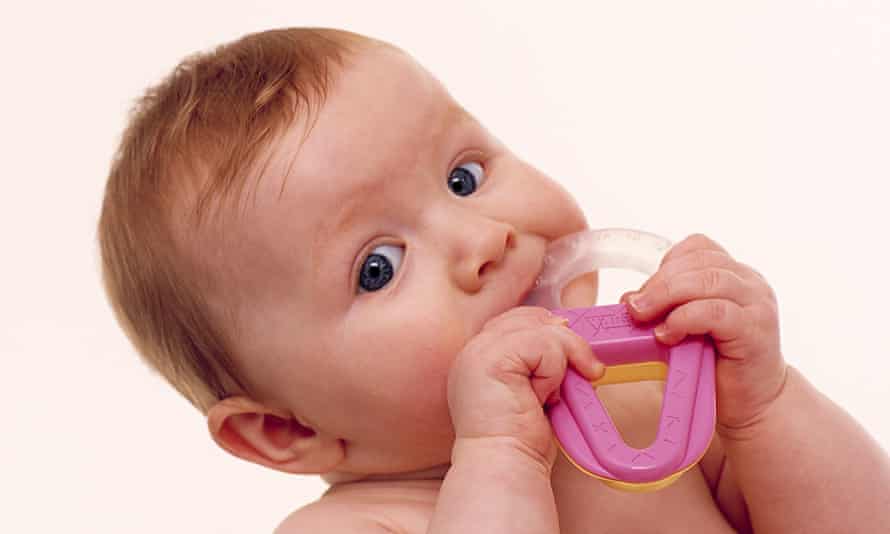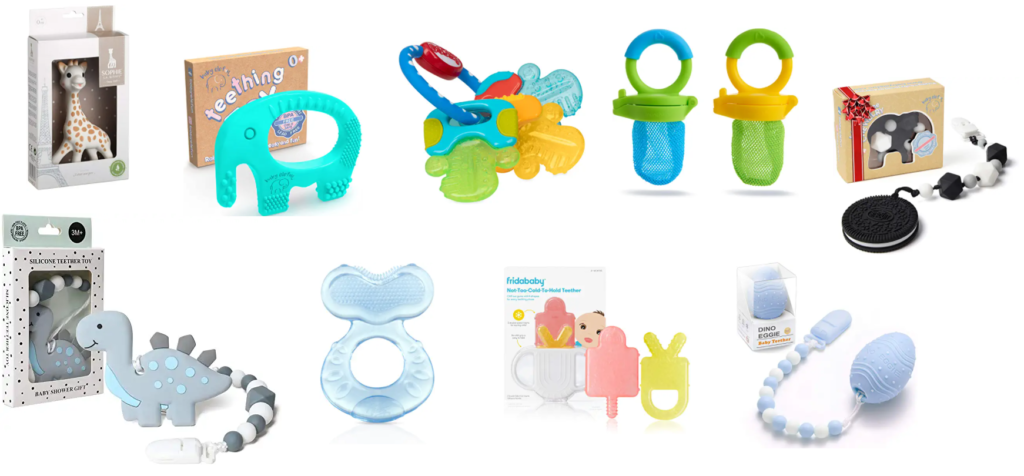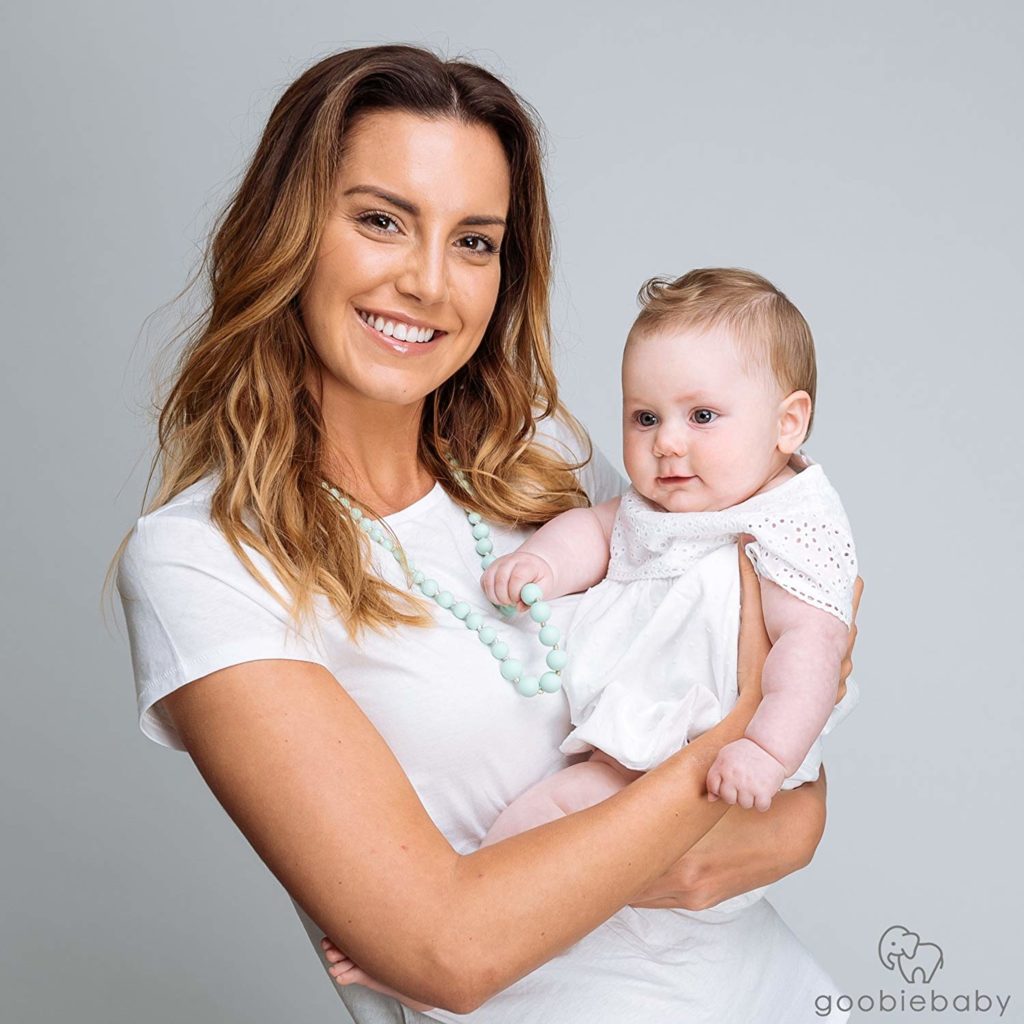
Whether it’s your first baby or it’s just been awhile since you’ve dealt with teething troubles, when your child starts showing those first signs of cutting a new tooth, you may be wondering what to expect next. Read on for a comprehensive guide on what to expect when your baby starts teething, how you can effectively treat teething pain and what happens after those shiny new teeth come in.
What Age Does Teething Start?
Most babies begin to cut their first tooth at around 6 months old. However, every child is different and teething can begin as early as 2 months and as late as 12 months. If you have any concerns about your child’s teeth not coming in properly, you can always check with a dentist to be sure everything looks as it should.
Which Teeth Come In First?
Typically, the bottom central incisors will come in first, followed by the top central incisors. Next comes the top and bottom lateral incisors, the canines and lastly the molars.
How Long Does Teething Last?
Teething can be a very long process since your child’s teeth will most likely come in 1 or 2 at a time until around the age of 3. This doesn’t necessarily mean that your child will be in pain or exhibiting symptoms during that entire time period. Each tooth usually comes in quite slowly and the most painful part of the process is when the tooth actually breaks through the gums for the first time. Once the gums are broken, there shouldn’t be much pain as the tooth continues to grow outward and into place.
What Are The Signs Of Teething?
There are many different ways to tell that something is beginning to happen in your child’s mouth. Some of these signs include chewing on everything in sight, excessive drooling, an increased desire to nurse more frequently and increased wakefulness at night due to the pain. Irritability is another major sign that your baby is experiencing some kind of discomfort or pain. Some babies run a mild fever, some get very fussy, and others show no signs at all until you see that first tooth come in.
While a mild fever is common in teething infants, a temperature over 100.4 is likely to be due to another cause, and you should consult a doctor if you suspect your child has a true fever.
How To Cope With Teething Pain?
When teething begins, your baby may be in pain or simply discomfort as they learn to cope with a new sensation in their mouth. The #1 question most parents will be asking once teething begins is how to help their child with teething pain? There are many ways to relieve this pain and discomfort including the methods on this list below:
- Hyland’s Baby Oral Relief Tablets – These popular tablets are a natural homeopathic remedy that many parents have sworn by over the decades. Although these tablets were at the center of some controversy a few years ago, the company’s new formula has eliminated the disputed ingredient of belladonna and is now even safer than before for natural teething pain relief.
- Boiron Camilia Teething Relief – This is another popular homeopathic formulation designed to relieve teething pain in infants. This natural teething treatment comes in sealed individual liquid doses rather than tablets.
- Other Natural Remedies – Some natural herbs that parents swear by for teething relief include Clove, Chamomile and Rosehip. One way to give these remedies to baby is to make a tea and then serve to baby to drink, apply directly onto the gums, or add to a teething toy or washcloth.
- Teething Toys – Teething toys, especially those you can freeze, are a very effective way to help with the pain and discomfort of cutting a new tooth. Baby teething toys come in all shapes and sizes including pacifiers, rings, sticks and even mittens.

Click here to view the Best Selling baby teethers!
- Frozen Washcloth – You can also freeze a clean washcloth for baby to gnaw on. This has proven to be a very effective (and budget-friendly!) method of teething relief for centuries.
- Teething Necklaces (for mom) – These are designed for mama to wear and baby to chew on. The texture of the natural materials used in these special teething necklaces is just right for baby to chew on without pain. They can even be popped in the freezer like a variety of other teething toys. One benefit of using a teething necklace instead of a toy: the teething relief is always on hand, never forgotten at home, and won’t fall on the floor or get dirty like a teething ring or other toy would. When looking for this type of necklace, you’ll want to avoid plastic (even those that say BPA-free) and stick to better quality ingredients such as untreated wood, food-grade silicone, and natural rubber.

- Amber Teething Necklaces (for baby) – These special teething necklaces are NOT designed for baby to chew on. The hope is that the healing properties of the amber stones help calm the child, reduce the low-grade fevers caused by teething, and even provide some pain relief. While some are skeptical if these special necklaces truly provide any relief, other parents swear by them to help calm their fussy babies when nothing else will. There have been scientific studies which show that succinic acid (contained in Baltic amber) can act as an analgesic. So if you decide it’s worth a shot, be sure to look for one with a breakaway clasp and always use carefully and under parental supervision. Some parents even chose to wrap the necklace around baby’s ankle at night for safer sleeping.
- Teething Biscuits – For those babies who just always have to be chewing on something, teething biscuits can be another great way to provide pain relief and get babies used to chowing down on solid foods. Some parents even refrigerate these biscuits for even better pain relief.
- Cold Foods – Since cool temperatures help provide relief, frequently offering refrigerated or frozen baby-friendly snacks such as applesauce, frozen fruit and yogurt is another great way to kill 2 birds with 1 stone. Frozen fruit can be placed in a special mesh teething pouch for safer use.
- Medications – OTC medicine such as Infant Tylenol, Infant Motrin can be given if all other methods don’t seem to be working. (Double check with your doctor on safety and proper dosing for your child’s age) However, medication should be a very last resort for young infants. As a caution – gels like Baby Orajel are generally not recommended due to their low effectiveness and risk of serious side effects.
What Happens Now?
After teething is underway, there are some new aspects of parenting to keep in mind for this new journey of parenting a child with teeth. This includes:
- Baby’s First Dentist Appointment – The AAP recommends that every child visit a dentist some time before their 1st birthday. This helps establish a routine in the home for good dental hygiene, gets kids used to visiting the dentist, and ensures that any problems or unhealthy habits are caught and addressed early.
- Oral Hygiene – You can now begin gently brushing your child’s teeth with a special baby-sized toothbrush and infant toothpaste. In these beginning stages of teething, you could even use a washcloth or a special soft brush that fits over your thumb for an even gentler brushing experience. Remember, you will likely need to help your child with brushing until they are well into their elementary school years.
- Cavity Prevention & Treatment – Some general recommendations to avoid cavities in young children include: limiting candy and other sugary foods, not allowing your child to take a bottle or sippy cup to bed, and regularly brushing their teeth after meals and before bed. Don’t be discouraged if your child does develop cavities at a young age. Sometimes the issue is just hereditary and a child’s tooth enamel doesn’t form properly like it should. There are many pediatric dentists who specialize in how to treat cavities at a young age. Before getting any fillings when your child is this young, try to get a second opinion to make sure it is truly necessary, as some dentists prefer not to fill baby teeth unless the decay is very severe. Sometimes there are even other treatments that can be done to help stop the decay without needing to resort to fillings.
- Loss Of Baby Teeth – Beginning around the age of 6, your child will start the process all over again when they begin losing their baby teeth and their adult teeth start coming in. After wiggling their loose tooth for a few days or weeks, it should fall out on its own when it is ready. Then, the new tooth will start to come in a few weeks or months later. While this may cause some discomfort or mild pain, most children are not particularly bothered by their new adult teeth coming in. The worst part of this process is again when the tooth cuts through the gums which may cause some mild pain lasting a day or 2.
The teething stage doesn’t last forever. As with all parenting milestones, this too shall pass. And when it does, you’ll be just a little bit older and wiser, and ready to pass your newfound knowledge on to other battle-weary parents. We hope the tips and advice found in this article help you know what to expect in the meantime!
